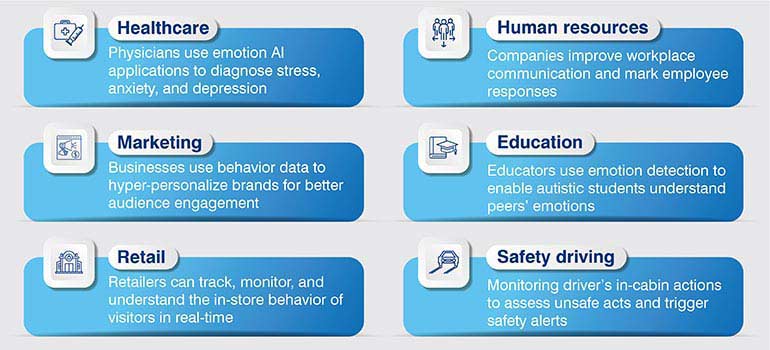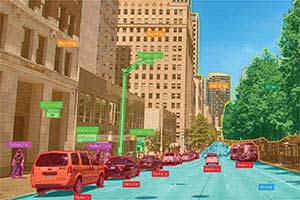How Human Data Annotations Shape Generative AI
Reliable emotion detection is the holy grail of deep learning and AI research. The creation of AI models that consistently recognize and contextualize human emotions promises revolutionary applications across industries.
Widespread use of emotion detection technology is empowering companies to analyze and have insights into customers to improve products and services. American giants like Amazon, Microsoft, and Google are already offering basic emotion analysis while developing enterprises like Affectiva, Hitech, and HireVue tailor it for specific sectors such as automotive, advertisers, and recruiters.
However, the ultimate success of emotion detection AI models depends solely on diverse and accurately annotated images and labeled data. The article will walk you through the importance of image annotation for emotion detection, the exciting application of emotion detection AI, and some of the prominent stumbling blocks.
Without annotations, images and videos make little sense to AI and machine learning models. AI sees them as just matrices of color codes, shapes, and outlines without any special significance. But with accurate and information-rich image annotations, AI and ML can connect images to related patterns of emotion and behavior. This in turn makes it possible for AI to create useful alerts and reports, and further meaningful analysis of the data by strategists.
Emotion detection systems are bound to generate erroneous signals and reports if they cannot estimate the significance of gestures or expressions against their contexts. And for this too, they must depend on scientifically created tags, transcriptions, or annotations.
The emotion detection industry is projected to almost double from $19.5bn in 2020 to $37.1bn by 2026.

Implementing emotion detection AI has challenges that stand in the way of businesses looking to utilize it. Challenges are typically faced in:
Want accurately annotated images to train your AI models?
Image annotation techniques allow ML models to identify facial and behavioral expressions, like gestures, shapes, and patterns of eye, mouth, nose, eyebrows, and their movements. The accuracy of those conclusions depends upon the fidelity of image annotation process. Thus, best image annotation practices ensure:

The first important job of any image annotation method is to successfully identify each image component. This essentially means identifying objects in their natural settings in a manner that makes sense to machines. With emotion detection AI, labeling involves tagging and identifying all those points that relate to the facial features or body movements of an individual indicating an expression or a mood.
When labeling is precise, computer vision algorithms can build a high-quality repository of different expressions – anger, joy, disgust, surprise, happiness, etc. This digital repository can then be reliably used by the model to predict audience emotions.

Training an emotion classifier is a multi-stage process and demands a rich dataset. Advanced image annotation systems use a combination of approaches involving automated labeling techniques and packages to build a robust dataset in a short time.
The process to train AI/ML models comprises of two parts, pre-training and final application of the model. In the pre-training stage, a base model is developed. After analyzing the results of a model trained on multiple faces, it is finally applied to test dataset to check its reliability.

Sound expertise in image annotation can allow you to arrive at the best annotation techniques and strategies. To give a real-world example, a premature approach to drive facial recognition was preventing a leading facial recognition solution developer from analyzing image data of 100 US retail stores.
The experts dug deep to explore image annotation in detail, ultimately discovering techniques for electronic article surveillance (EAS) and exception reporting. The results gave success: More than 6,000 images were annotated for analysis generating 15,000-plus alerts on probable in-store threats. Greater accuracy in the detection of shoplifting and fraud identification shortened the response time of law enforcers.

Distances between eyes, eye socket depth, nose pattern – including length and width, and jawline structure, when perceived together, determine an expression or mood. Interestingly within 5 years from 2014, facial recognition systems become 20x better when operating over a database of 12 million images, with the failure rate dipping to 0.2%.
One domain that has intensified the use of facial recognition is retail. For instance, Jack & Jone’s smart store based in Shenzhen in China understands customers’ emotions, offering them personalized recommendations. Automatic inclusion as members in the shoppers’ group and cash-less and card-less payment are other benefits that these smart stores offer.

To deliver excellence, emotion detection systems require images to be pre-processed. Image processing techniques correct poorly illuminated or unclear images, repair the resolution, color, and outlines. Best image annotation framework not only labels and tags images, but also incorporates image processing and image correction techniques to render perfect images.
Image pre-processing involves correcting unwanted blurs, removing noises, and adjusting filters to achieve natural levels of sharpness. Additionally, image processors can apply morphological processing, which involves boundary extraction and erosion techniques. These help to produce images that can successfully go into the image annotation loop.

Image annotation frameworks have adapted to the domain on short notice. Authorities at the Panama international airport leverage facial recognition and emotion detection systems for smuggler detection and to prevent security infringement.
Backed by thousands of well-annotated images, the system helps identify individuals who are involved in serious crimes. The database continues to evolve and quality image annotation at the backend has helped authorities at the airport capture culprits who visited the airport even after a decade’s gap.

Resting on the basic principle of identifying the trajectory of pixels on faces, landmark annotation helps to track changing facial features. The summation of features gives an overall understanding of the emotion.
With just a few dots, the technique helps determine the current emotion and sentiments of a person.
Similarly, semantic annotation associates every single pixel of interest with a tag. With these characteristics, the technique is highly useful in annotating moving bodies, or objects that demand accurate identification. Making driving safer is a typical example where semantic annotation proves handy. It helps determine the movement of a driver inside the cabin, excluding moving but non-useful elements like shadows.
Disney uses emotion-decoding technology to test volunteer’s reactions to its Star Wars films. Marketing firms are using emotion detection to find out audiences respond to advertisements of Coca-Cola and Intel. And that’s just not it.
Lincolnshire police in the UK, and public security bureau in Altay city in Xinjiang; use emotion recognition systems to identify criminals and suspicious people. With employees working from home and students studying online during corona virus, technology companies are selling emotion recognition software to monitor workers and students remotely.
Irrespective of the application, the goal is to make humans less inscrutable/mysterious and easy to predict at scale.
AI-based emotion detection holds the potential to revolutionize industries by the use of models that can identify and contextualize human emotions. But practical and reliable applications of emotion-AI depend on proper image annotations and related techniques and practices.
With much of their efforts concentrated on data processing, exploratory data analysis, and fine-tuning models, machine learning / AI engineers and data scientists can hardly devote the requisite time to image annotation. Simultaneously, they cannot afford their AI initiatives to suffer as a result of time or cost constraints. The recourse – collaborate with an expert.
What’s next? Message us a brief description of your project.
Our experts will review and get back to you within one business day with free consultation for successful implementation.
Disclaimer:
HitechDigital Solutions LLP and Hitech BPO will never ask for money or commission to offer jobs or projects. In the event you are contacted by any person with job offer in our companies, please reach out to us at info@hitechbpo.com